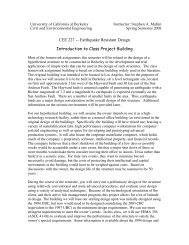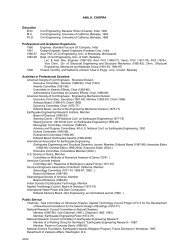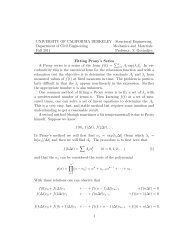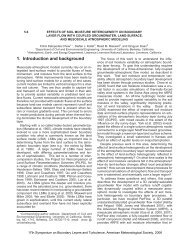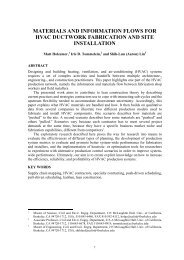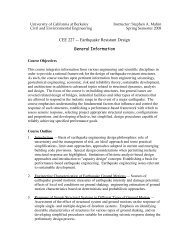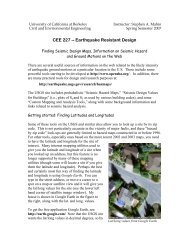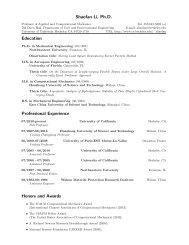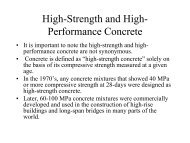A penny-shaped cohesive crack model for material damage
A penny-shaped cohesive crack model for material damage
A penny-shaped cohesive crack model for material damage
- No tags were found...
Create successful ePaper yourself
Turn your PDF publications into a flip-book with our unique Google optimized e-Paper software.
306 G. Wang, S.F. Li / Theoretical and Applied Fracture Mechanics 42 (2004) 303–316where I (2) = d ij e i e j is the second-order identitytensor. By the averaging theorem, it is obvious thatmean macro stress, defined as R m ¼ 1 R 3 kk, equalsapplied remote stress,R m ¼ r 1ð8ÞIn cylindrical coordinate, the traction conditionson the remote boundary oV 1 and symmetric displacementboundary condition are expressed asr zz j oV 1¼ r hh j oV 1¼ r rr j oV 1¼ R m ð9ÞFig. 2. A <strong>penny</strong>-<strong>shaped</strong> <strong>cohesive</strong> <strong>crack</strong> in representativevolume element (the shaded region: <strong>cohesive</strong> zone—yieldedring).Chen and Keer re-examined the problem, and theyobtained general solutions <strong>for</strong> a <strong>penny</strong>-<strong>shaped</strong><strong>cohesive</strong> <strong>crack</strong> under mixed-mode loading [5,6].On the other hand, however, the problem hasnot been thoroughly examined from micromechanicsperspective. For example, the connectionamong the onset value of <strong>cohesive</strong> strength, microyield stress in an RVE, and remote macro stresshas not been made. By examining a <strong>cohesive</strong><strong>penny</strong>-<strong>shaped</strong> <strong>crack</strong> in an RVE, the study providesa link among <strong>cohesive</strong> strength, yield stress of virgin<strong>material</strong>, and remote stresses on the boundaryof an RVE, which provides foundation <strong>for</strong> ensuinghomogenizations.Consider a three-dimensional <strong>penny</strong>-<strong>shaped</strong>Dugdale <strong>crack</strong> of radius a with a ring-<strong>shaped</strong> <strong>cohesive</strong>zone with width b a in an RVE, which maybe viewed as an infinite isotropic space by ‘‘amicro-observer ’’ inside the RVE.Let the outward normal to <strong>crack</strong> surface parallelto Z(X 3 ) axis (see Fig. 2) and uni<strong>for</strong>m triaxialtension stress is applied at the remote boundaryof the RVE, i.e.r 1 ¼ r 1 I ð2Þð7Þu z ðr; h; 0Þ ¼0 <strong>for</strong> b 6 r; 0 6 h 6 2p ð10ÞThe stress distribution on the <strong>crack</strong> surface and<strong>cohesive</strong> zone isr zz ðr; h; 0Þ ¼r 0 Hðr aÞ<strong>for</strong> 0 6 r 6 b; 0 6 h 6 2pð11Þwhere R m is the remote stress, H(r a) is theHeaviside function, and r 0 is the <strong>material</strong>Õs <strong>cohesive</strong>strength, the onset value <strong>for</strong> <strong>crack</strong> opening,and it is different from the micro yielding stress.The problem can be solved via superposition oftwo sub-problems: a trivial problem—an intactRVE in uni<strong>for</strong>m triaxial tension state, i.e. "x2V,r ð0Þzzr ð0Þrz¼ r ð0Þhh¼ r ð0Þrh¼ rð0Þ rr¼ R m ð12Þ¼ rð0Þ zh ¼ 0 ð13Þand a <strong>crack</strong> problem—an RVE with a center <strong>crack</strong>that is subjected to the following boundary conditions(see Fig. 3):r ðcÞzz j oV 1¼ r ðcÞhh j oV 1¼ r ðcÞrr j oV 1¼ 0 ð14Þr ðcÞzz ðr; h; 0Þ ¼ R m þ r 0 Hðr aÞ<strong>for</strong> 0 6 r 6 b; 0 6 h 6 2pð15Þu ðcÞzðr; h; 0Þ ¼0 <strong>for</strong> b 6 r; 0 6 h 6 2p ð16ÞFor the <strong>crack</strong> problem, the <strong>crack</strong> opening displacementcould be solved as8>:2p2p1 v l 1 v l R mR mpffiffiffiffiffiffiffiffiffiffiffiffiffiffib 2 r 2pffiffiffiffiffiffiffiffiffiffiffiffiffiffib 2 r 2R bpffiffiffiffiffiffiffiffiffiffiffiffiffipr 0 ta2 a 2 = ffiffiffiffiffiffiffiffiffiffiffiffiffi t 2 r 2 dt ; 0 < r < aR bpffiffiffiffiffiffiffiffiffiffiffiffiffipr 0 tr2 a 2 = ffiffiffiffiffiffiffiffiffiffiffiffiffi t 2 r 2 dt ; a < r < bð17Þ



